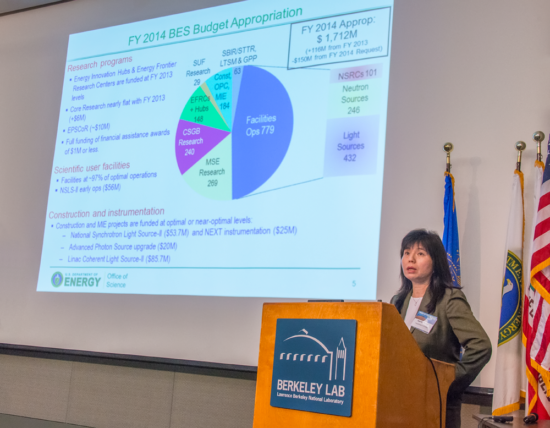The 2014 ALS User Meeting launched with 422 attendees and a welcome from UEC Chair Peter Nico. Don DePaolo, Associate Lab Director for Energy and Environmental Sciences, followed with his own welcome and then spoke about the pivotal role of the ALS in the future of the Lab. DePaolo highlighted the synergies between the Molecular Foundry and NERSC and the ALS, and encouraged users to take advantage of those.
ALS Director Roger Falcone was up next and he began with a sad acknowledgement of the passing of a veteran ALS user, Dennis Lindle. While the past year has been a tough one in terms of funding realities for the ALS, Falcone pointed to highlights in scientific achievements. The ALS had a record number of users in 2014, with an impressive number of publications to accompany that trend. Falcone also stressed the synergistic capabilities of the ALS and Molecular Foundry.

DOE Associate Director of Science for Basic Energy Science (BES), Dr. Harriet Kung, took the stage to give users a Washington update, acknowledging that the past year and future year’s budgets are quite challenging for the department. She said her department has been “heartened by the proactive steps that facilities have taken to align with our funding realities.” The next step, as she sees it, is to figure out how to survive and grow in today’s economic environment. As an upgrade project is in the early planning stages for the ALS, Kung encouraged users to think about making wise scientific and technical choices to remain competitive in the midst of a potentially lengthy upgrade process. Kung ended with a nod to funding situation once again, encouraging users to lend their support in the effort to “strongly defend the level of funding needed.”
John Hill, X-Ray Scattering Group Leader Brookhaven National Lab, spoke about high temperature superconductivity and charge correlations, which he describes as “a complicated problem led by the discovery of the products and also the promise of the materials.” The driving force behind this research area is the promise of superior electricity generation. Researchers have been trying to understand superconductors for more than 30 years, and the ALS has allowed them to understand more.
Sam Bader, Chief Scientist for Argonne’s National Lab’s Center for Nanoscale Materials, followed up with how the ALS has enhanced the scientific community’s understanding of spintronics. He described nanomagnetism as the oldest field in science, but at the forefront of new materials. His studies in vortex physics and medical applications marry biology and physics to address promising new brain cancer treatments.
Next up was UC Berkeley’s Jim Hurley, a cell biologist who spoke about “cellular self cannibalism,” a topic with a catchy title and an intriguing story. The self cannibalism refers to the autophagy process whereby cells cannibalize themselves, which is a process of survival involved in most diseases. As we age, Hurley explained, autophagy slows down and the rate of damage is no longer offset by self cannibalism, which is not always a good thing (take cancer cells, for example). Crystallography at the ALS is helping Hurley and his colleagues discover more about the process of autophagy.
Afternoon speakers included Yayoi Takamura from UC Davis, who spoke about the usefulness of complex oxide nanostructures, and William Chueh from Stanford University, who spoke about nano spectromicroscopy and battery kinetics.
ALS staff updates included User Services group lead Sue Bailey, who gave users an update on the new ALSHub process, and David Robin, ALS Division Deputy for Accelerator Operations, who reviewed accelerator, instrumentation, and controls upgrades.
Students from across the country and around the world then took the stage to briefly present their research for the annual student poster slam. At the poster session and reception that evening, the students fielded questions about their work, with first prize going to Kamran Ghiossi from UC Davis, whose poster focused on progress in fullerene x-ray crystallography.
Day two featured Berkeley Lab’s Mayram Farmand speaking on ptychographic imaging of nanomaterials, followed by the student poster award winner Kamran Ghiassi who discussed his poster “Progress in Fullerene X-Ray Crytallography.”. Chuck Fadley, Shirley Award Winner, talked about depth-resolved ARPES. Molecular Foundry Director Jeff Neaton gave ALS users an overview of the Foundry and potential opportunities for ALS users. James Sethian from the Center for Applied Mathematics for Energy Related Applications (CAMERA) spoke to users about CAMERA and senior scientist Musa Ahmed, Chemical Sciences Division, spoke about new insights into soot formation.
The final speaker of the afternoon, Scripps Research Institute’s Erica Saphire, brought some audience members to tears with her discussion of the current Ebola virus outbreak and the race for a cure. Saphire is an ALS user whose x-ray crystallography work contributed to the development of a promising Ebola treatment.

Afternoon workshops and the evening awards dinner were well-attended, with the following awards given out:
David A. Shirley Award for Outstanding Scientific Achievement at the ALS to Charles (Chuck) Fadley for “for significant contributions to a better understanding of surfaces and interfaces through the development of novel x-ray photoemission spectroscopy techniques.”
Klaus Halbach Award for Innovative Instrumentation at the ALS to Alastair MacDowell, Hrishikesh Bale, Abdel Haboub. James Nasiatka, Dilworth (Dula) Parkinson and Robert (Rob) Ritchie for “for the development of tomography of composite materials at ultra-high temperatures resulting in unique new capabilities in materials science.”
Tim Renner User Services Award for Outstanding Support to the ALS User Community to Tony Warwick “for reforming, formalizing, streamlining and documenting the Beamline Review Committee (BRC) over a ten year chairmanship for the benefit of those that follow.”